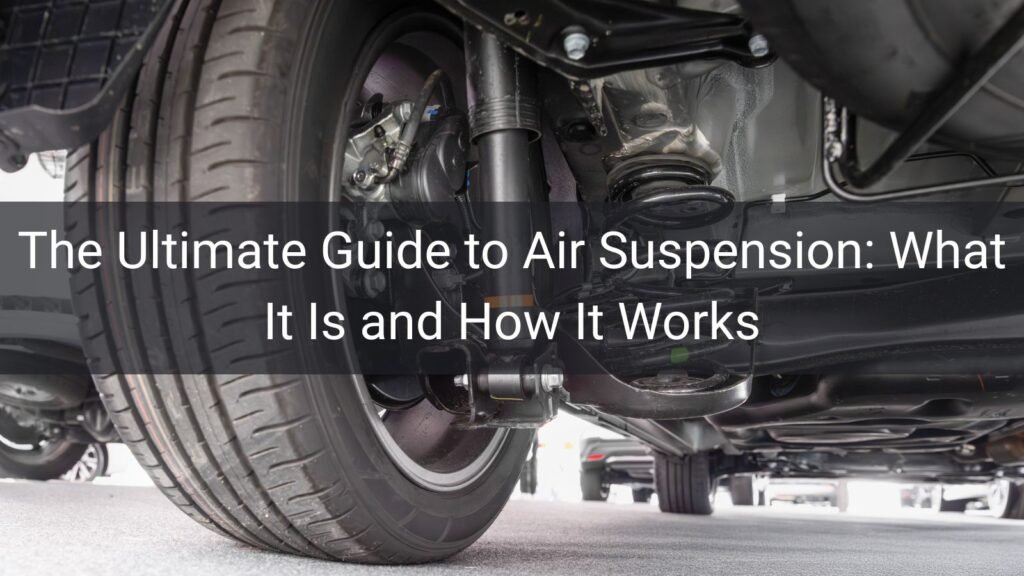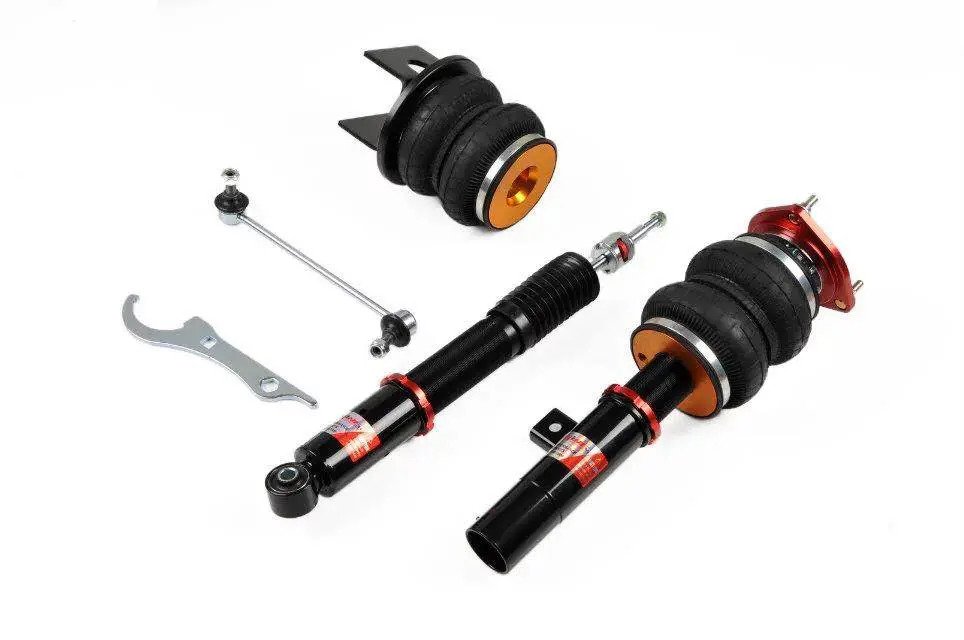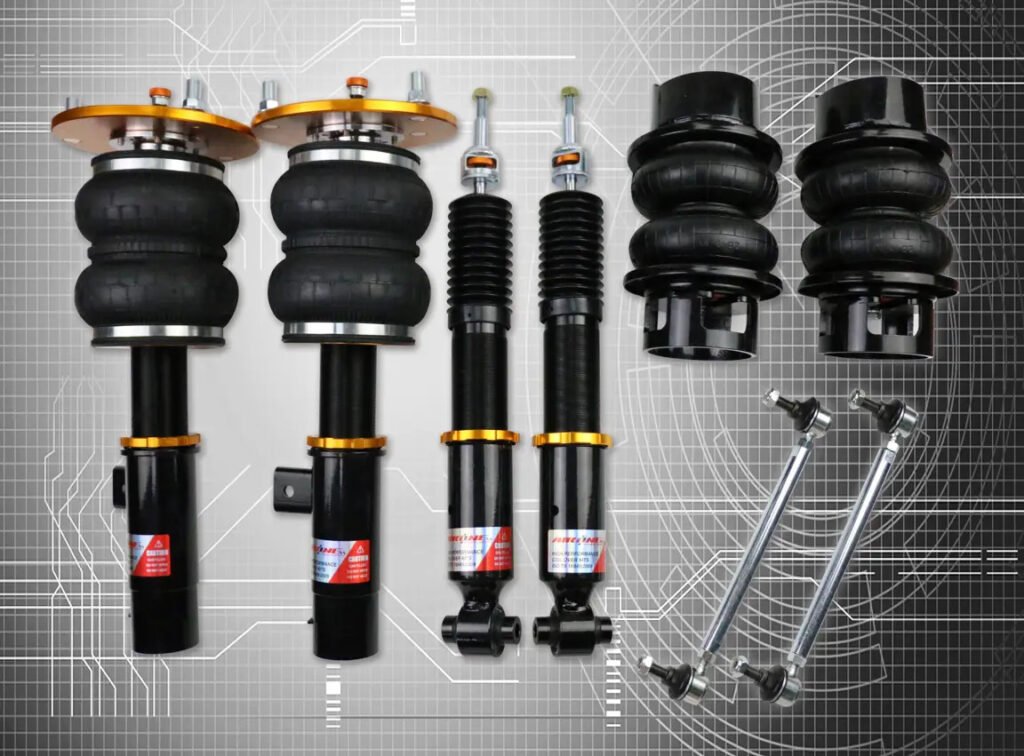
Air suspension systems represent one of the most sophisticated advancements in automotive engineering, transforming the way vehicles handle road conditions and provide comfort to passengers. This comprehensive guide explores everything you need to know about air suspension technology, from its basic principles to its practical applications in modern vehicles. Whether you’re considering upgrading your vehicle’s suspension system or simply want to understand this innovative technology, this article will provide you with expert insights and practical knowledge.
Table of Contents
What is Air Suspension?
Air suspension, also known as air ride suspension or air bag suspension, is an advanced vehicle suspension system that uses compressed air instead of traditional steel springs to support the vehicle’s weight and absorb road impacts. This sophisticated technology replaces conventional coil springs, leaf springs, or struts with flexible air bags (also called air springs or air bellows) that can be inflated or deflated to adjust the vehicle’s ride height and stiffness.
The system consists of several key components working in harmony: air springs, an air compressor, air reservoir tanks, electronic control modules, and a network of valves and sensors. Unlike traditional suspension systems that offer fixed characteristics, air suspension provides dynamic adjustability, allowing drivers to modify their vehicle’s performance characteristics on demand.
| Component | Function | Material |
|---|---|---|
| Air Springs/Bags | Support vehicle weight and absorb impacts | Reinforced rubber compounds |
| Air Compressor | Generates compressed air for the system | Steel and aluminum alloys |
| Control Module | Manages system operation and adjustments | Electronic components |
| Sensors | Monitor ride height and system pressure | Electronic sensors |
How Air Suspension Works
Understanding how air suspension works requires examining the intricate interplay between mechanical and electronic components. The system operates on the fundamental principle of using compressed air as a variable spring medium, providing unprecedented control over vehicle dynamics.
When the vehicle encounters different road conditions or load changes, sensors throughout the suspension system detect variations in ride height, acceleration, and other parameters. These sensors send real-time data to the electronic control unit (ECU), which processes the information and automatically adjusts the air pressure in each air spring accordingly.
The air compressor, typically powered by the vehicle’s electrical system, draws ambient air through a filtration system and compresses it to the required pressure. This compressed air is stored in reservoir tanks and distributed to individual air springs through a network of valves and air lines. The system can increase pressure to raise the vehicle or release air to lower it, providing instant adjustability that traditional springs cannot match.
Modern air suspension systems incorporate sophisticated algorithms that consider factors such as vehicle speed, cornering forces, braking dynamics, and load distribution. This comprehensive approach ensures optimal performance across diverse driving conditions, from highway cruising to off-road adventures.
Types of Air Suspension Systems

Air suspension technology has evolved into several distinct categories, each designed to meet specific performance requirements and budget considerations. Understanding these variations helps consumers make informed decisions about their suspension needs.
Manual Air Suspension
Manual systems represent the most basic form of air suspension technology. These systems require driver intervention to adjust ride height and pressure settings through dashboard controls or external switches. While less sophisticated than automated systems, manual air suspension offers significant advantages over traditional springs at a more affordable price point.
Semi-Active Air Suspension
Semi-active systems incorporate electronic control modules that automatically maintain predetermined ride heights while allowing manual adjustments for specific driving conditions. These systems strike a balance between automation and user control, making them popular among enthusiasts who want both convenience and customization.
Fully Active Electronic Air Suspension
The most advanced air suspension systems feature comprehensive electronic control with real-time adjustments based on road conditions, driving style, and vehicle load. These systems offer improved ride quality by automatically adjusting the suspension parameters continuously, providing the ultimate in comfort and performance.
| System Type | Control Method | Adjustment Speed | Cost Level |
|---|---|---|---|
| Manual | Driver-operated switches | Moderate | Entry-level |
| Semi-Active | Electronic with manual override | Fast | Mid-range |
| Fully Active | Fully automated electronic | Instantaneous | Premium |
History and Evolution
The concept of air suspension dates back to the early 20th century, but practical applications didn’t emerge until the 1940s. The technology was initially developed for commercial and industrial applications, where the ability to adjust vehicle height and load capacity provided significant operational advantages.
General Motors introduced the first automotive air suspension system in 1957 on select Cadillac and Buick models. However, early systems suffered from reliability issues and high costs, limiting their adoption. The technology remained primarily in luxury vehicles and commercial applications for several decades.
The modern renaissance of air suspension began in the 1980s and 1990s with advances in materials science, electronic controls, and manufacturing processes. European luxury manufacturers, particularly Mercedes-Benz and BMW, pioneered sophisticated air suspension systems that combined reliability with advanced functionality.
Today’s air suspension systems benefit from decades of refinement and innovation. The global air suspension systems market is projected to expand at CAGR of 9.6% during the forecast period, with the market expected to reach USD 20.70 billion in 2025, reflecting the technology’s growing acceptance and continuous improvement.
Key Advantages and Benefits

Air suspension systems offer numerous advantages over traditional spring-based suspension, making them increasingly popular across various vehicle categories. These benefits extend beyond simple ride comfort to encompass performance, versatility, and practical utility.
Superior Ride Quality
The primary advantage of air suspension is its ability to provide exceptional ride comfort across diverse conditions. The variable spring rate allows the system to remain soft for comfort during normal driving while automatically stiffening for improved handling during aggressive maneuvers.
Load Leveling Capability
Air suspension automatically adjusts to maintain consistent ride height regardless of vehicle load. This feature is particularly valuable for trucks, SUVs, and commercial vehicles that frequently carry varying loads. The system ensures optimal headlight alignment, aerodynamics, and handling characteristics regardless of cargo weight.
Adjustable Ground Clearance
The ability to raise or lower the vehicle provides practical benefits in various situations. Lower ride heights improve aerodynamics and fuel efficiency at highway speeds, while increased ground clearance enables better off-road capability and easier entry/exit for passengers.
Enhanced Vehicle Dynamics
Modern air suspension systems can adjust damping characteristics in real-time, optimizing the suspension setup for current driving conditions. This adaptability provides better handling, reduced body roll, and improved stability compared to passive systems.
Applications and Uses
Air suspension technology finds applications across a diverse range of vehicle types and use cases, each benefiting from the system’s unique characteristics and capabilities.
Luxury Vehicles
Premium automobiles utilize air suspension to provide the ultimate in ride comfort and refinement. The system’s ability to isolate passengers from road imperfections while maintaining precise handling characteristics makes it ideal for luxury applications.
Commercial and Heavy-Duty Applications
Trucks, buses, and commercial vehicles benefit significantly from air suspension’s load-leveling capabilities and durability. The technology improves ride quality for drivers while protecting cargo from excessive vibration and impact.
Performance and Sports Applications
High-performance vehicles use air suspension to combine comfort with track-worthy handling. The ability to lower the vehicle for improved aerodynamics and raise it for practical use makes air suspension popular among sports car manufacturers and enthusiasts.
Off-Road and Adventure Vehicles
Off-road enthusiasts appreciate air suspension’s ability to provide maximum ground clearance when needed while maintaining on-road comfort. The technology enables vehicles to adapt to challenging terrain while preserving ride quality on paved roads.
Maintenance and Considerations
While air suspension systems offer numerous advantages, they require proper maintenance and understanding of their operational characteristics. Regular maintenance ensures optimal performance and longevity of these sophisticated systems.
Regular Inspection Points
Air suspension systems require periodic inspection of air lines, connections, and air bags for signs of wear or damage. The rubber components are particularly susceptible to environmental factors and require attention to prevent premature failure.
System Diagnostics
Modern air suspension systems incorporate comprehensive diagnostic capabilities that monitor system performance and alert users to potential issues. Regular diagnostic checks help identify problems before they result in system failure.
Quality Components Matter
The reliability and performance of air suspension systems depend heavily on component quality. At Max Auto, we understand this critical relationship and manufacture our air suspension components using aircraft-grade 6063 aluminum and heavy-gauge steel with powder coat finish for superior corrosion resistance and durability.
Our air struts utilize high-quality rubber compounds specifically formulated for longevity and performance. Unlike cheaper alternatives that may crack or degrade over time, our rubber construction maintains flexibility and effectiveness throughout the component’s service life.
Choosing the Right Air Suspension System
Selecting the appropriate air suspension system requires careful consideration of your specific needs, budget, and vehicle requirements. The decision involves balancing performance expectations with practical considerations.
Application-Specific Requirements
Different applications demand different suspension characteristics. Daily drivers prioritize comfort and reliability, while performance applications may emphasize adjustability and handling precision. Commercial applications focus on durability and load capacity.
Budget Considerations
Air suspension systems are available across a wide price range, from basic manual systems to sophisticated electronic setups. Understanding the features and benefits of each category helps identify the best value for your specific requirements.
Professional Installation and Support
The complexity of modern air suspension systems often necessitates professional installation and ongoing support. Choose suppliers who provide comprehensive technical assistance and quality assurance.
| Vehicle Type | Recommended System | Key Features | Primary Benefits |
|---|---|---|---|
| Luxury Sedan | Fully Active Electronic | Real-time adjustment, multiple driving modes | Ultimate comfort and handling |
| SUV/Truck | Semi-Active | Load leveling, height adjustment | Versatility and capability |
| Sports Car | Performance-Tuned Active | Track modes, precision control | Handling and adjustability |
| Commercial Vehicle | Heavy-Duty Manual/Semi-Active | Durability, load capacity | Reliability and efficiency |
Max Auto’s Commitment to Excellence
At Max Auto, we specialize in providing high-quality air suspension solutions tailored to diverse applications and requirements. Our extensive experience in shock absorber technology and automotive components ensures that every air suspension kit meets the highest standards of performance and reliability.
Our Air Suspension Kits include front and rear air struts designed for easy bolt-on installation without modifications to OEM components. The systems feature 32 levels of damping adjustment and height adjustability (0-120/200mm depending on vehicle), providing near-infinite customization possibilities.
We back our products with a comprehensive one-year warranty and provide ongoing technical support to ensure optimal performance throughout the system’s service life. For detailed specifications and vehicle-specific applications, contact us at sales@maxautoparts.cn or call +86 15267273091.
Visit our website at https://www.nbmaxauto.com/ for complete product catalogs and technical resources. Send “air suspension catalog” by email to receive detailed information about vehicle-specific applications and specifications.
Located at Building No.2, Jinshan Road No.788, Jiangbei District, Ningbo City, Zhejiang, China, Max Auto combines advanced manufacturing capabilities with rigorous quality control to deliver superior air suspension solutions for customers worldwide. Our TS16949 certification demonstrates our commitment to automotive quality standards and continuous improvement.
Air suspension technology continues to evolve, offering increasingly sophisticated solutions for modern vehicles. Understanding the principles, benefits, and applications of these systems empowers consumers to make informed decisions about their suspension needs while enjoying the superior performance and comfort that air suspension provides.
